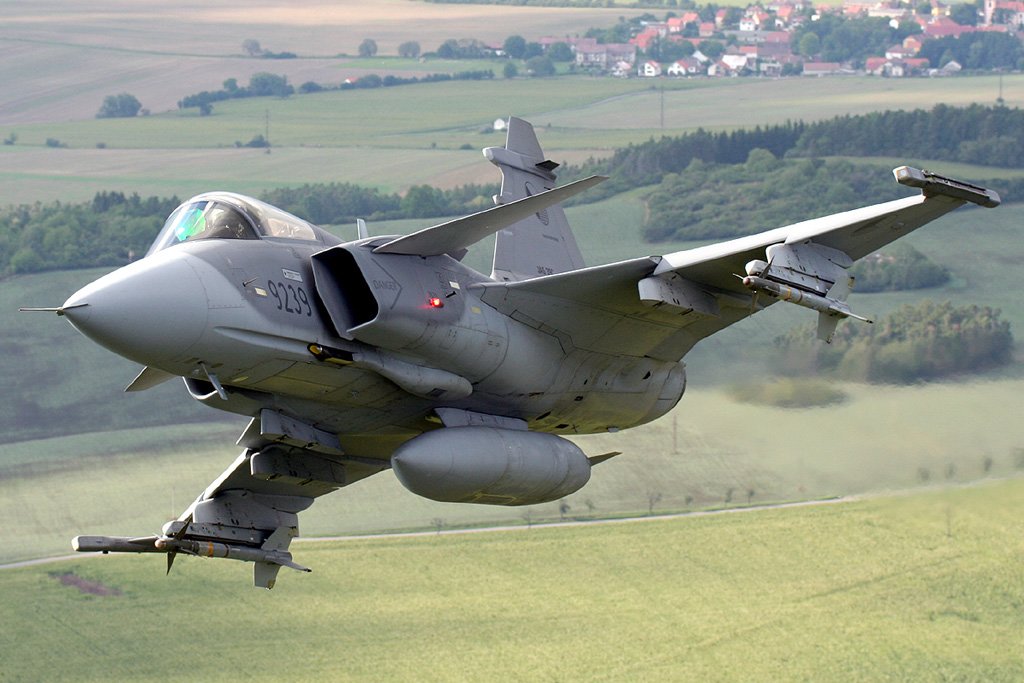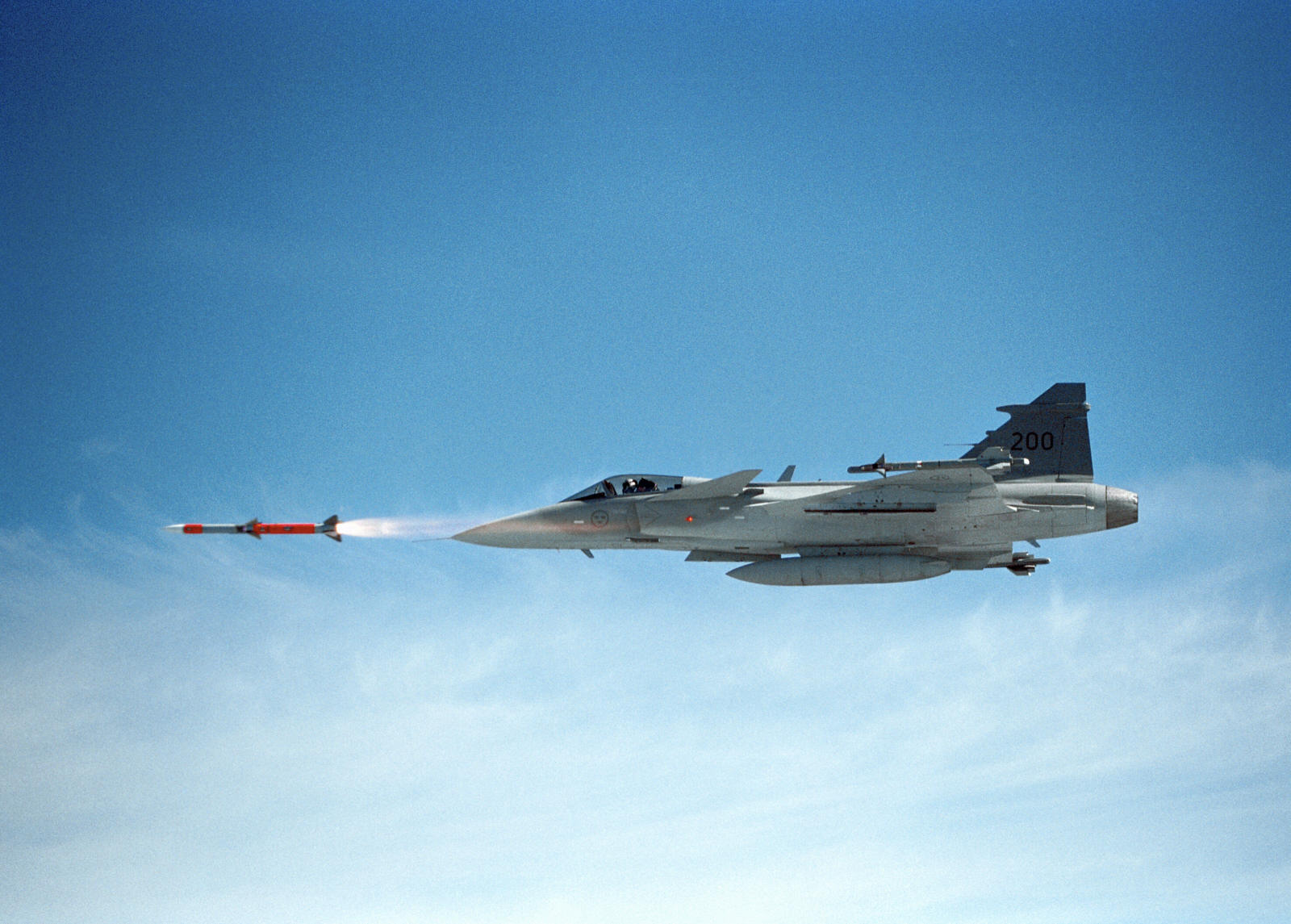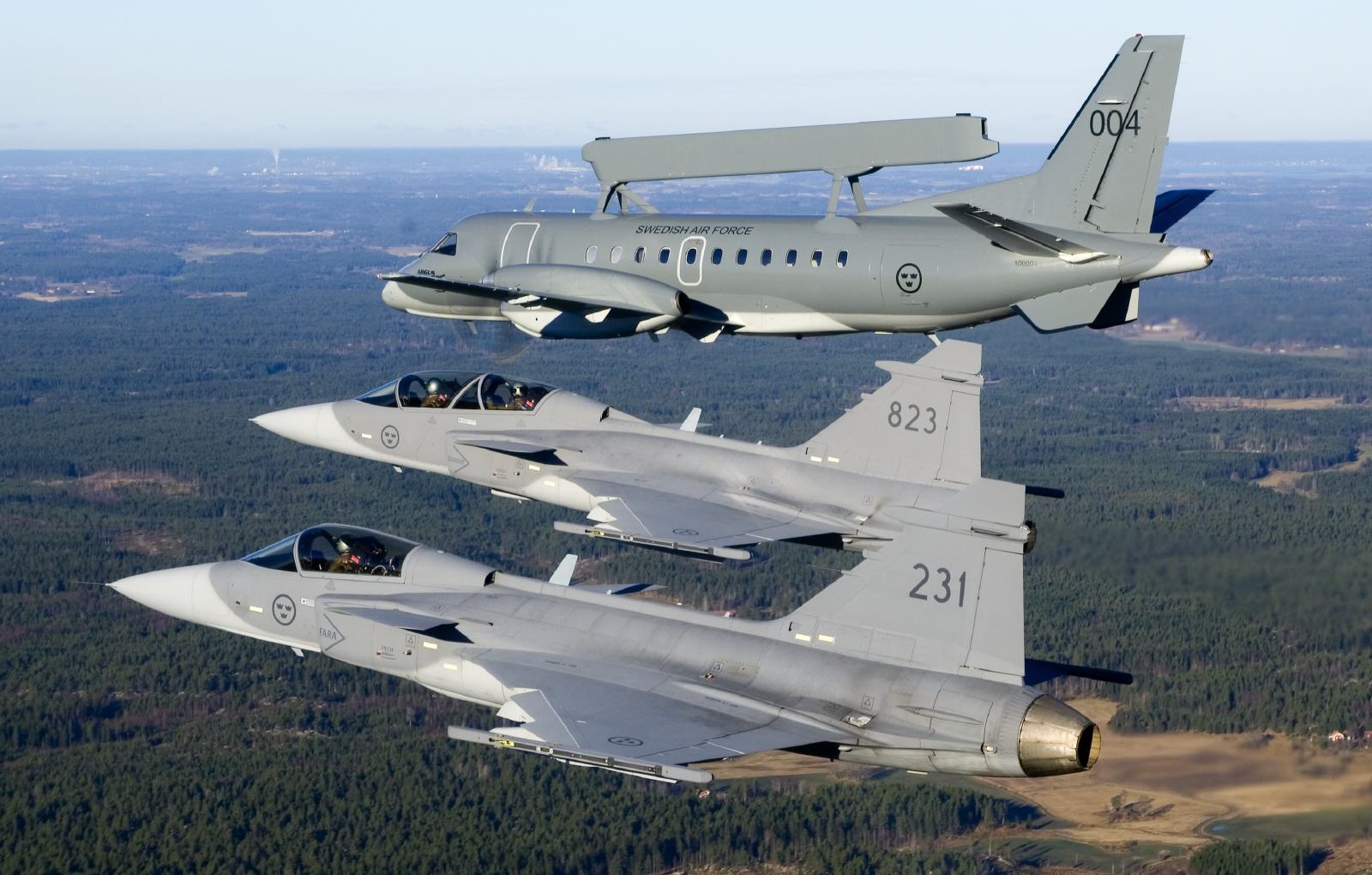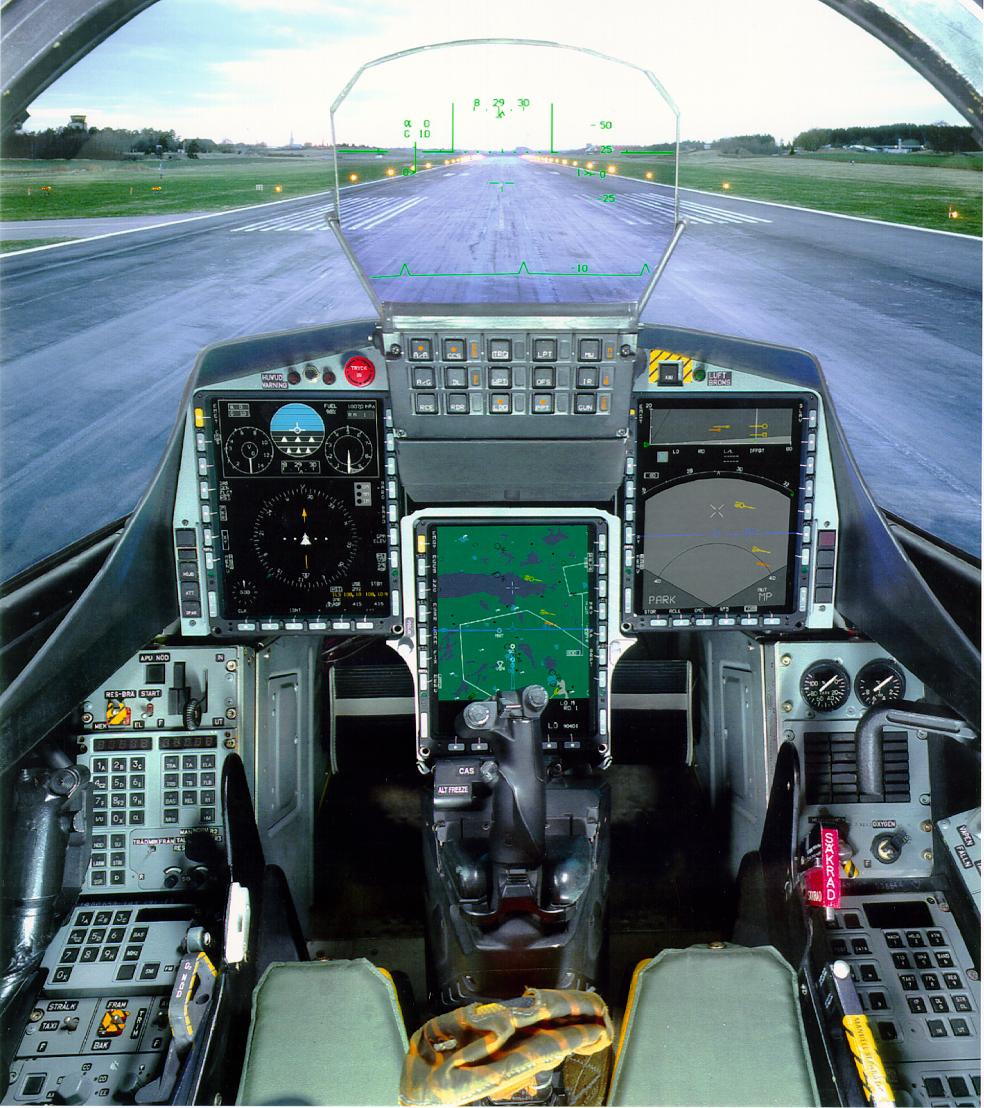
| JAS 39 Gripen | |
|---|---|
| A JAS 39C with a JAS 39D behind, both of the Swedish Air Force, Brno, CIAF 2007 | |
| Role | Multirole fighter |
| Manufacturer | Saab |
| First flight | 9 December 1988 |
| Introduction | 9 June 1996 |
| Status | Active service |
| Primary users | Swedish Air Force Czech Air Force Hungarian Air Force South African Air Force |
| Number built | 213 as of December 2008[update][1][2] |
| Unit cost | US$40-61 million (export price VAT excluded)[3][4] |
The Saab JAS 39 Gripen (English: Griffin) is a fighter aircraft manufactured by the Swedish aerospace company Saab. Gripen International acts as a prime contracting organisation and is responsible for marketing, selling and supporting the Gripen fighter around the world.
The aircraft is in service with the Swedish Air Force, the Czech Air Force, the Hungarian Air Force and the South African Air Force, and has been ordered by the Royal Thai Air Force. A total of 236 Gripens have been ordered as of 2008.General characteristics
- Crew: 1 (2 for JAS 39B/D)
- Length: 14.1 m (46 ft 3 in)
- Wingspan: 8.4 m (27 ft 7 in)
- Height: 4.5 m (14 ft 9 in)
- Wing area: 30.0 m² (323 ft²)
- Empty weight: 5,700 kg (14,600 lb)
- Loaded weight: 8,500 kg (18,700 lb)
- Max takeoff weight: 14,000 kg (31,000 lb)
- Powerplant: 1× Volvo Aero RM12 afterburning turbofan
- Dry thrust: 54 kN (12,100 lbf)
- Thrust with afterburner: 80.5 kN (18,100 lbf)
- Wheel track: 2.4 m (7 ft 10 in)
- Length (two-seater): 14.8 m (48 ft 5 in)
Performance
- Maximum speed:
- At altitude: Mach 2 (2,130 km/h, 1,320 mph)
- Combat radius: 800 km (500 mi, 432 nmi)
- Ferry range: 3,200 km (2,000 mi) with drop tanks
- Service ceiling: 15,240 m (50,000 ft)
- Wing loading: 336 kg/m² (68.8 lb/ft²)
- Thrust/weight: 0.97
Armament
- 1 × 27 mm Mauser BK-27 cannon 120 rounds
- 6 × Rb.74 (AIM-9) or Rb 98 (IRIS-T)
- 4 × Rb.99 (AIM-120) or MICA
- 4 x Rb.71 (Skyflash) or Meteor
- 4 x Rb.75
- 2 x KEPD.350
- 4 x GBU-12 Paveway II laser-guided bomb
- 4 x rocket pods 13.5 cm rockets
- 2 x Rbs.15F anti-ship missile
- 2 x Bk.90 cluster bomb
- 8 x Mark 82 bombs
- 1 x ALQ-TLS ECM pod
Development
By the late 1970s a replacement for Sweden's ageing Saab 35 Draken and Saab 37 Viggen was needed.[6] A new fighter was being considered by 1979,[7] with design studies beginning the following year.[6] The development of the Gripen began in 1982 with approval from Swedish Parliament.[8]
The Gripen was designed for performance, flexibility, effectiveness and survivability in air combat. The designation JAS stands for Jakt (Air-to-Air), Attack (Air-to-Surface), and Spaning (Reconnaissance), indicating that the Gripen is a multirole or swingrole fighter aircraft that can fulfill each mission type. The JAS 39 received the name Gripen through a public competition in 1982.[9] The griffin is the heraldry on Saab's logo and suited the multirole characteristics of the aircraft. Furthermore, the griffin is the symbolic animal on the coat of arms of Östergötland, the province in which Saab AB is headquartered (Linköping).
Sweden chose to develop the Gripen rather than purchase a variant of the F-16, F/A-18A/B, or the "F-5S" version of the Northrop F-20 Tigershark. The first Gripen was rolled out on 26 April 1987, marking Saab's 50th anniversary.[10] The first prototype first flew on 9 December 1988.[11]
On 26 November 2008, the final aircraft of the latest 64 jet Batch 3 contract was delivered to FMV.[1] This was accomplished at a 10% less than the agreed-upon price for the whole batch, putting the Gripen 39C fly-away price at under USD 30 million.
Design

In designing the aircraft, several layouts were studied. Saab ultimately selected an unstable canard design. The canard configuration gives a high onset of pitch rate and low drag, enabling the aircraft to be faster, have longer range and carry a larger payload.
The combination of delta wing and canards gives the Gripen significantly better takeoff and landing performance and flying characteristics. The totally integrated avionics make it a "programmable" aircraft. It also has a built-in electronic warfare unit, making it possible to load more ordnance onto the aircraft without losing self defence capabilities. The 300-link is used to share data between fighters.[21]
The Gripen affords more flexibility than earlier generations of combat aircraft used by Sweden, and its operating costs are about two thirds of those for JA 37 Viggen.
In the Swedish Air Force's list of requirements was the ability to operate from 800 m runways. Early on in the programme, all flights from Saab's facility in Linköping were flown from within a 9 m × 800 m outline painted on the runway. Stopping distance was reduced by extending the relatively large air brakes; using the control surfaces to push the aircraft down, enabling the wheel brakes to apply more force and tilting the canards downwards, making them into large air brakes and further pushing the aircraft down.
Operators
[edit] Current operators
 Czech Republic
Czech Republic- Czech Air Force: 14 Gripens on lease, including 2 two-seaters.
 Hungary
Hungary- Hungarian Air Force: 14 Gripens on a lease-and-buy arrangement, including 2 two-seaters (C/D versions). The final three aircraft were delivered in December 2007.[69]
 South Africa
South Africa- South African Air Force: 26 aircraft ordered (down from 28), nine two-seater Ds and 17 single seat Cs.[70] The first delivery, a two-seater, took place on 30 April 2008.[31][71]
 Sweden
Sweden- Swedish Air Force: 204 aircraft originally ordered, including 28 two-seaters (138 in service). Sweden leases 28 of the aircraft, including four two-seaters, to the Czech and Hungarian Air Forces. In 2007 the Swedish government decided that the future Swedish Air Force will deploy no more than 100 JAS 39C/D Gripen fighters.[72] A program to upgrade 31 of the air force's JAS 39A/B fighters to JAS 39C/Ds was started.[73]
 United Kingdom
United Kingdom- Empire Test Pilots' School: Under the agreement, ETPS instructor pilots and students undergo simulator training with the Swedish Air Force, and go on to fly the two-seater Gripen at Saab in Linköping, in two training campaigns per year (spring and autumn). The agreement was renewed in 2008.[74]
[edit] Orders
 Thailand
Thailand- The Royal Thai Air Force: Six aircraft, four of them two-seaters,[75] have been slated for delivery in 2011, with a potential additional six at a later date.[76][77][78][79] The Gripens will replace the 12 F-5B/Es at Surat Thani Airbase.[80] On 12 February 2009, the Thai defence minister approved the second batch of six Gripens.[81]

PICTURES OF JAS-39












No comments:
Post a Comment